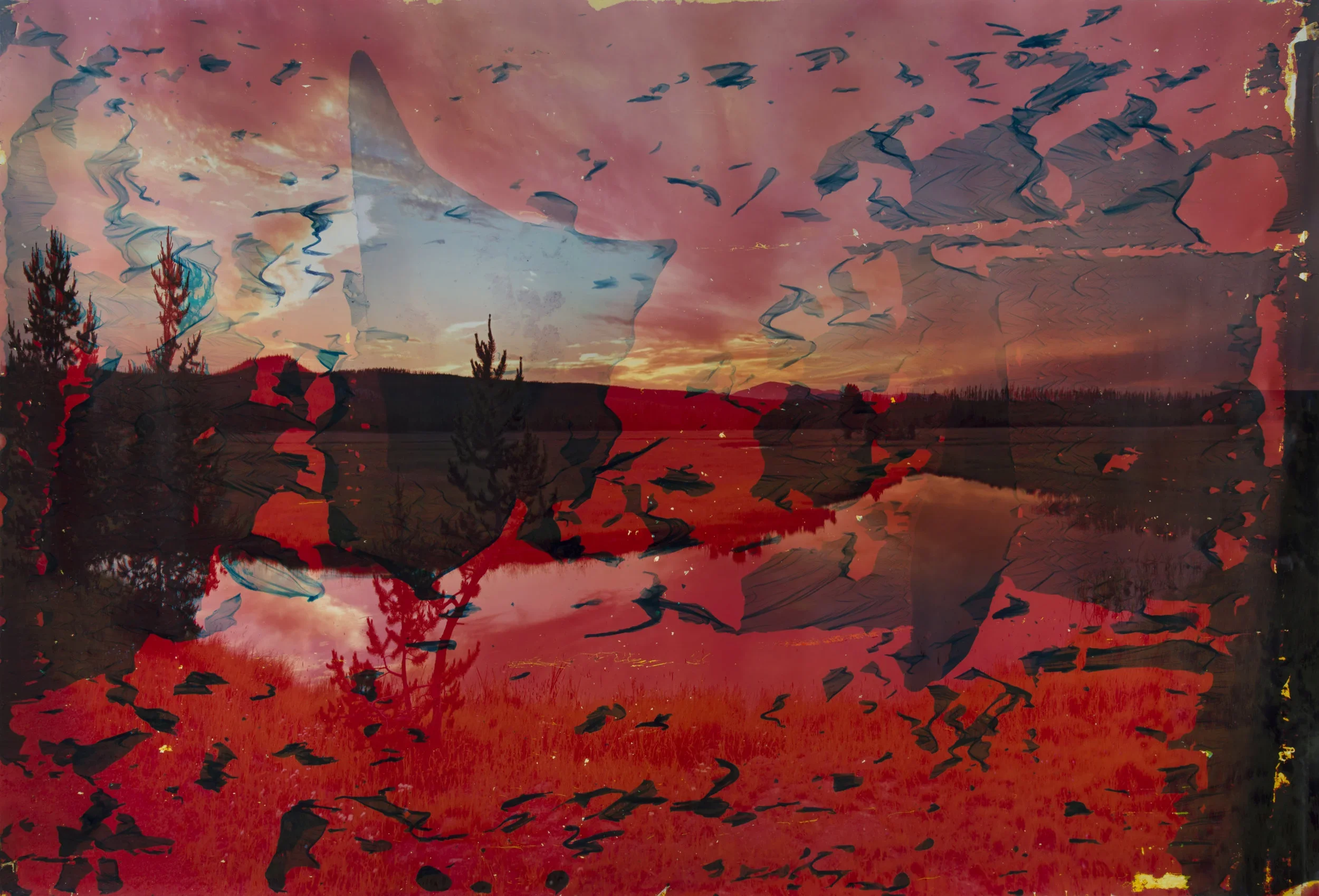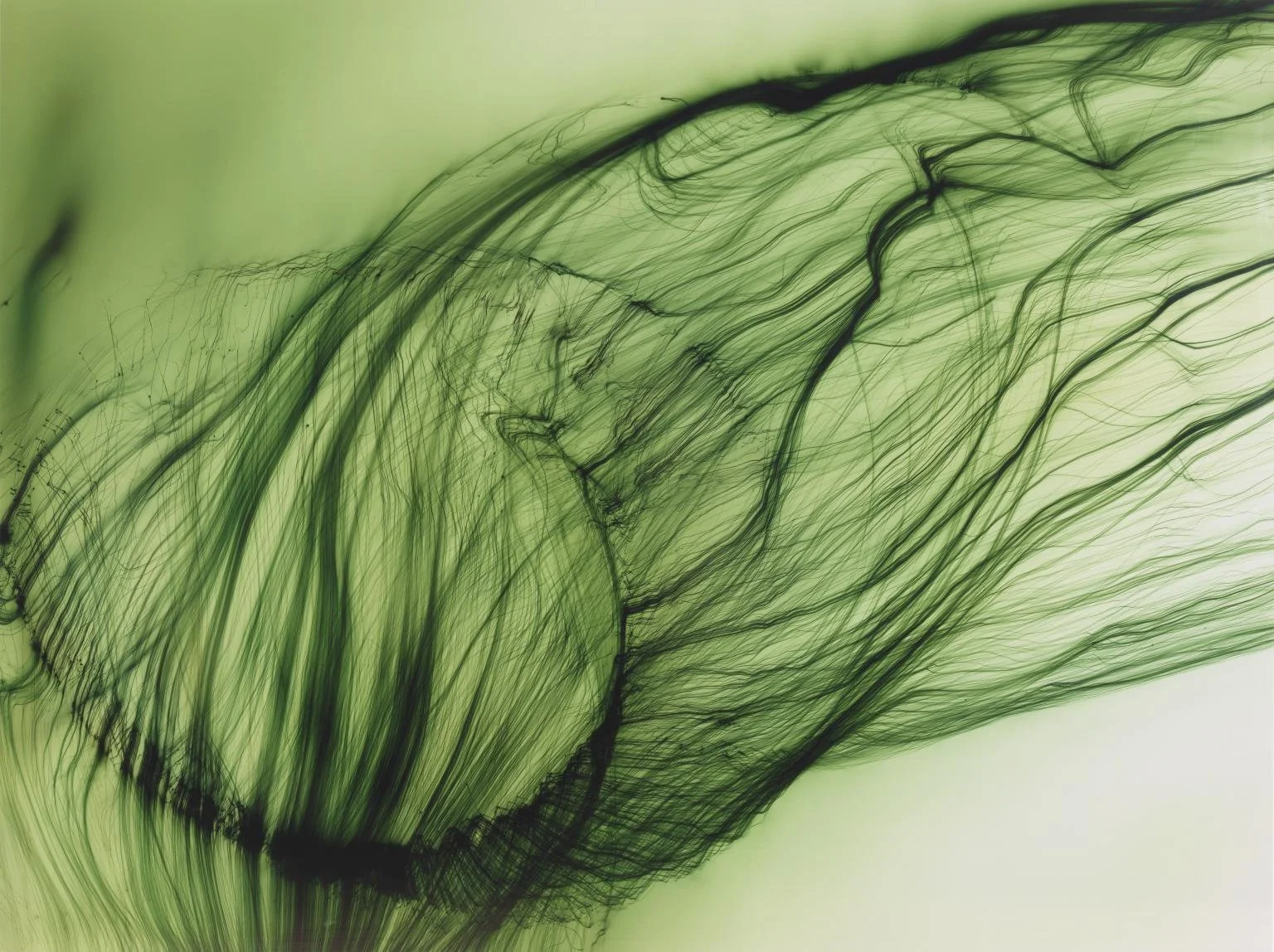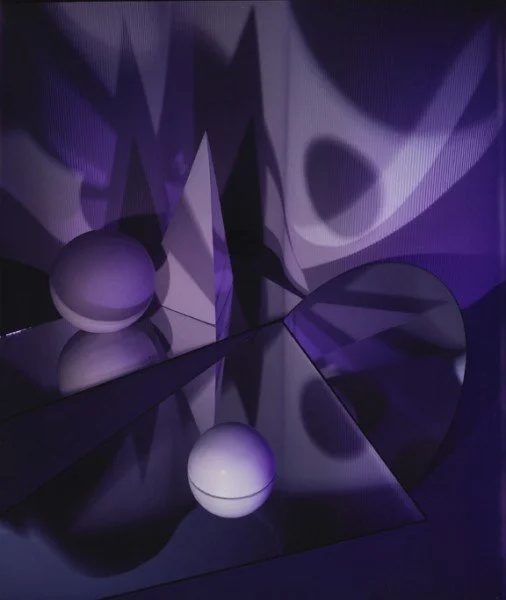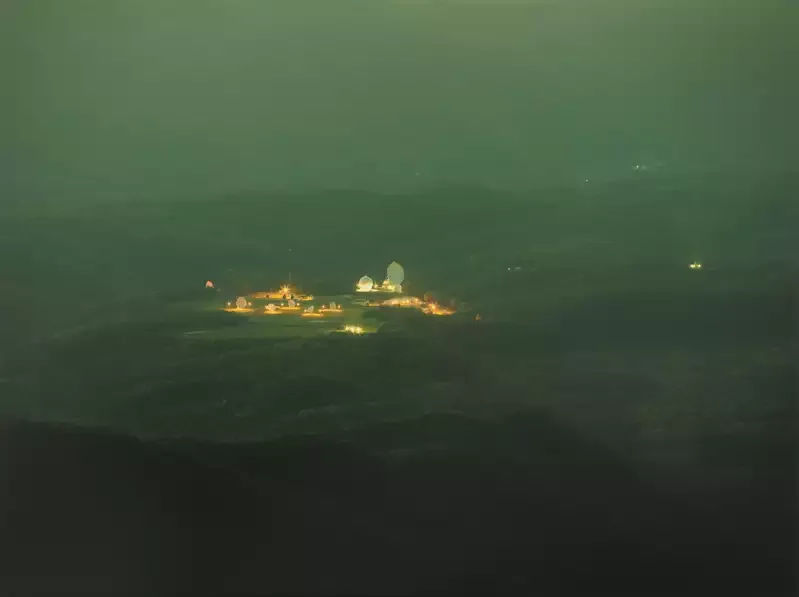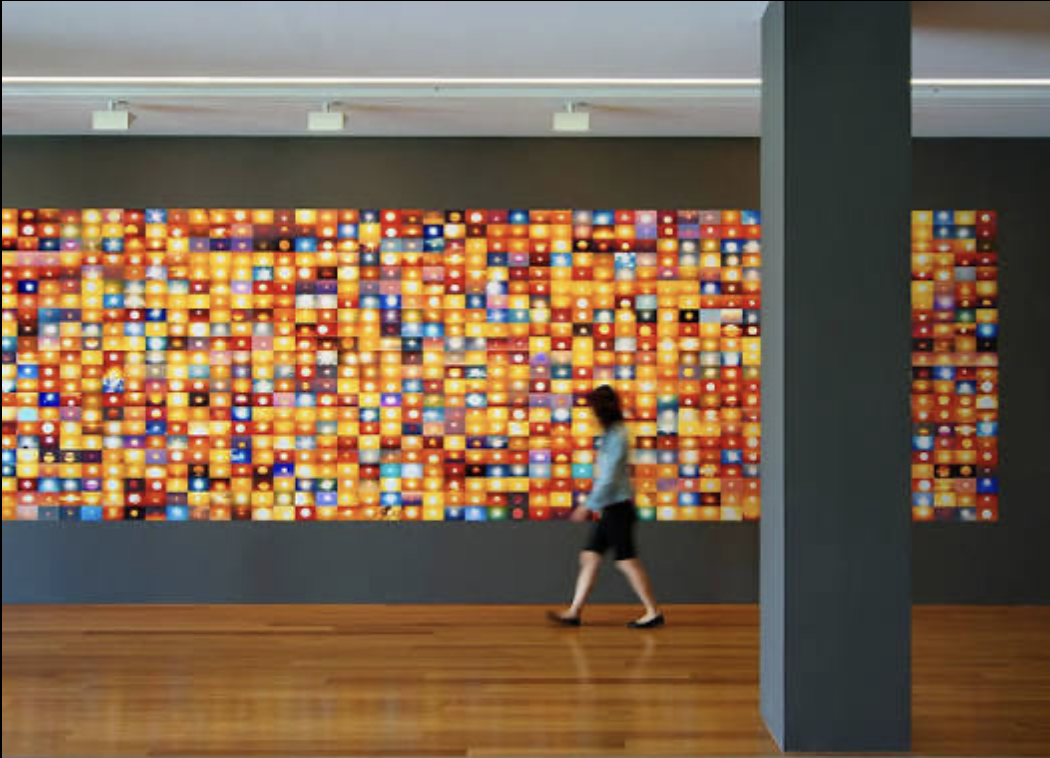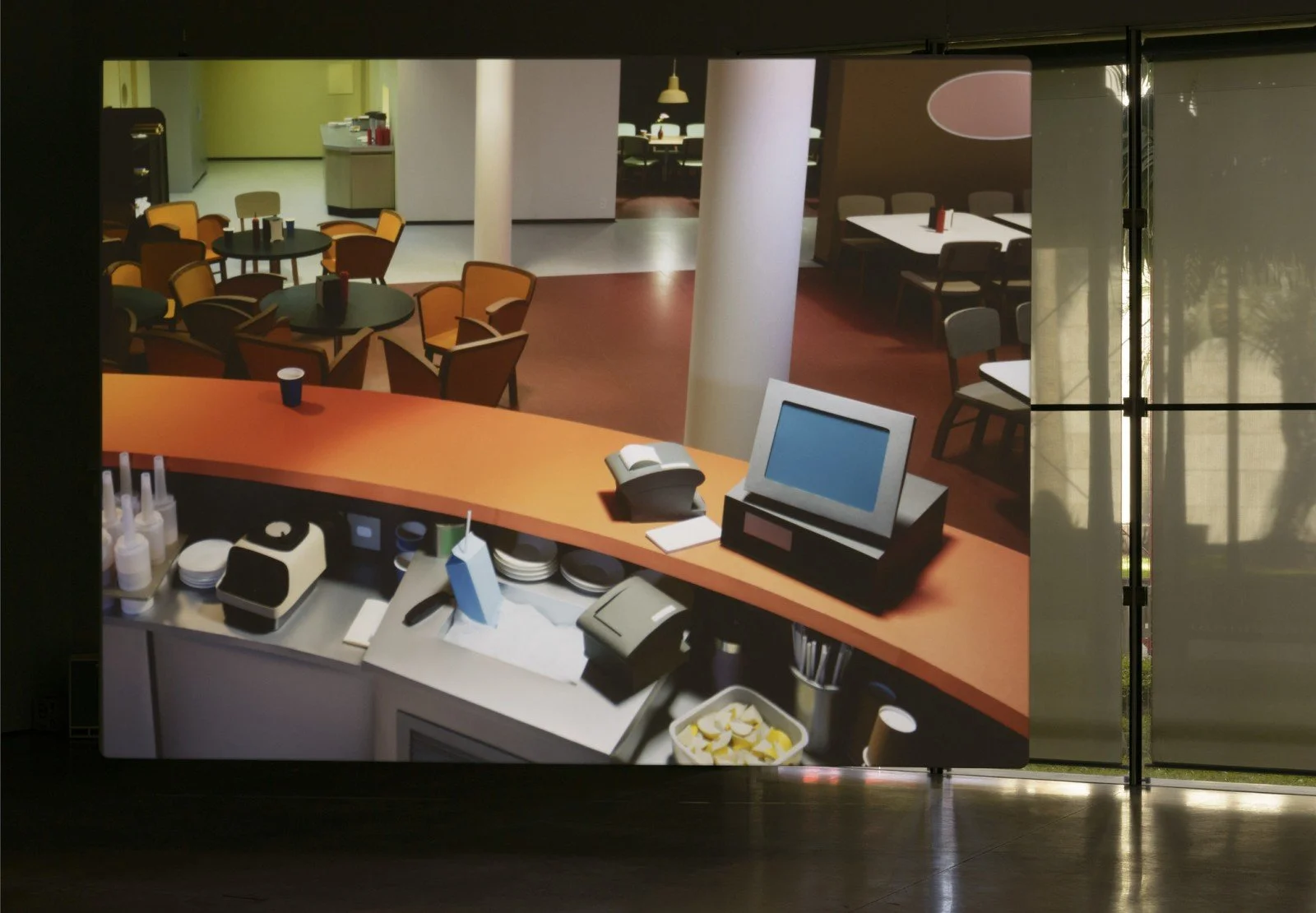Critical Annotation
Over this semester, my practice has moved toward a study of photography as a site of instability—where light, chemistry, and emotion interact in unpredictable ways. Things That Refuse to Settle grows from earlier interests in memory and space but now focuses on the residual and reactive qualities of the image. What interests me is not what a photograph shows, but what it does—how it continues to act on perception long after exposure.
The dossier has become a tool to trace this idea across different artistic languages. Works by Meghann Riepenhoff (1) and Matthew Brandt (2) show that photographic matter can collaborate with weather, water, and chance; their processes remind me that instability itself can be a form of authorship. By contrast, Alison Rossiter (3) and Marco Breuer (4) demonstrate how the darkroom becomes a performative site where destruction and preservation coexist. This idea resonates with my own use of herbal developers and expired papers.
Equally important are artists who question how vision is constructed. Uta Barth (5) and Wolfgang Tillmans (6) use blur and colour to stretch the limits of attention, while Taiyo Onorato & Nico Krebs (7) transform optical devices into sculptures that record their own uncertainty. These precedents have led me to consider perception as a temporal event rather than a stable frame.
Finally, projects by Trevor Paglen (8) and Hito Steyerl (9) highlight the political dimension of visibility. Their investigations into surveillance and digital image circulation remind me that every act of seeing also produces exclusion. My recent experiments with re-photography and solarised Instax prints borrow from this tension, asking how much information an image must reveal before it becomes complicit with systems of control.
Through this ongoing research, I have begun to see my work as part of a material and affective ecology—where photography operates not as representation but as reaction. The dossier, therefore, is less an archive of influence than a map of uncertainty: a record of how images, like memories, continue to shift, corrode, and reappear.
1.Riepenhoff, M. Littoral Drift. [Artwork]. 2013–.
Accessed 2/10/2025. https://meghannriepenhoff.com/project/littoral-drift/
2. Brandt, M. Lakes and Reservoirs. [Artwork]. 2011. Accessed 1/10/2025.
https://yossimilo.com/artists/46-matthew-brandt/works/
3. Rossiter, A. Expired Paper. [Artwork]. 2008–. Accessed 3/10/2025.
https://yossimilo.com/artists/30-alison-rossiter/works/
4. Breuer, M. Heat Series. [Artwork]. 2003. Accessed 24/8/2025.
https://marcobreuer.com/
5. Barth, U. Fields. [Artwork]. 1994–96. Accessed 20/9/2025.
https://utabarth.net/work/
6. Tillmans, W. Freischwimmer. [Artwork]. 2003.
https://www.wikiart.org/en/wolfgang-tillmans/freischwimmer
7. Onorato, T., & Krebs, N. The Great Unreal. [Artwork]. 2005-2009. Accessed 12/9/2025.
https://tonk.ch/series/the-great-unreal
8. Paglen, T. They Watch the Moon. [Artwork]. 2010.
https://www.artgallery.nsw.gov.au/collection/works/179.2023/
9. Steyerl, H. In Free Fall. [Video]. 2010. Accessed 18/10/2025.
https://www.qagoma.qld.gov.au/cinema/screening/in-free-fall-asia-one
Materials and Processes
Meghann Riepenhoff - Littoral Drift
Meghann Riepenhoff
Littoral Drift
2013– (Series)
Meghann Riepenhoff’s Littoral Drift explores the collaboration between photographic materials and the natural elements of the seashore, such as waves, rain, wind, and sediment. Rather than using a conventional camera, the artist submerges cyanotype-coated paper directly into coastal environments, allowing the process itself to register time, movement and erosion. The resulting works continue to change after creation, emphasising impermanence and material agency.
In my work, the way Riepenhoff invites nature into the image-making process resonates strongly with my interest in chemical and optical “side effects” of photography. Her approach encourages me to think of my own medium not simply as a tool of representation, but as an active site of transformation where environment, matter and memory collide.
Riepenhoff, M. (2013–). Littoral Drift. [Series].
Image source: meghannriepenhoff.com
Matthew Brandt - Lakes and Reservoirs
Matthew Brandt
Lakes and Reservoirs
2011 (Series)
Matthew Brandt’s Lakes and Reservoirs investigates the material intersection of subject and medium by photographing bodies of water, then immersing the resulting prints in water collected from those very sites. The water becomes an active agent of transformation—soaking the c-print, gradually degrading and re-colouring it—thus making the image both record and process. In doing so, Brandt challenges the notion of a pristine landscape photograph and instead emphasises the vulnerability and changeability of both environment and medium.
In relation to my own work, this approach resonates deeply: I am interested in how photographic materials themselves can refuse to settle, how the medium becomes porous, reactive, liable to change. Brandt’s technique of letting subject and medium merge encourages me to treat my own processes (solarisation, herbal developers, expired paper) not as mere aesthetic choices but as active collaborators in the formation of meaning and emotion.
Brandt, M. (2011). Lakes and Reservoirs. [Series].
Image source: matthewbrandt.com
Alison Rossiter - Expired Paper
Alison Rossiter
Expired Paper
2008– (Series)
Alison Rossiter’s Expired Paper examines the temporal agency of photographic materials through the use of decades-old, light-sensitive paper that long predates its expiry. By developing these dormant sheets without exposing them to external imagery, she transforms chemical instability, moisture, mould, and residual light into active image-forming agents. The resulting surfaces register time as both process and residue, turning the photographic paper into a site where decay performs the act of creation. As critics have observed, Rossiter’s practice redefines the photographic gesture: she does not capture an image but allows the medium to reveal its own metabolism.
Her approach has deeply informed how I think about the photographic “side-effect” as a generative condition. In my work, the material’s reaction, contamination, or failure is not corrected but cultivated as evidence of transformation. Rossiter’s methodology suggests that uncertainty and degradation are not oppositions to control but extensions of photographic life. This perspective enables me to approach my materials as co-authors—agents that inscribe time, instability, and memory within the surface of the image itself.
Rossiter, A. (2008–). Expired Paper. [Series].
Adam Jeppesen - Flatlands Camp Project
Adam Jeppesen
Flatlands Camp Project
2009–2014 (Series)
Adam Jeppesen’s Flatlands Camp Project emerged from a five-year solitary journey from the Arctic to Antarctica, during which the artist produced large-format negatives under harsh environmental conditions. These negatives were printed with minimal control, allowing dust, scratches, and light leaks to act as part of the image-making process. Many prints were later folded, abraded, or eroded through travel, turning the traces of fatigue and exposure into an aesthetic of endurance. Jeppesen’s project transforms imperfection into evidence, presenting the photograph as a fragile yet persistent artefact shaped by time, movement, and circumstance.
His approach has profoundly shaped my understanding of process and material fatigue within photographic practice. Rather than pursuing technical precision, I am drawn to the way deterioration and interference reveal the image’s own life cycle. Jeppesen’s conception of the photograph as a document of endurance parallels my experiments with expired paper and chemical reaction, affirming that every mark, fold, or stain can function as a residue of memory and a testament to transformation.
Jeppesen, A. (2009–2014). Flatlands Camp Project. [Series].
Perception and Installation
Uta Barth - Fields
Uta Barth
Fields
1995–1998 (Series)
Uta Barth’s Fields series investigates how attention, rather than subject, structures perception. By photographing out-of-focus interiors and subtle shifts of light, Barth transforms ordinary spaces into studies of vision itself. The blurred images deny the viewer a focal point, making the act of seeing—the awareness of light, distance, and hesitation—the true subject of the work.
In my own practice, Barth’s treatment of defocus and delay informs my exploration of perceptual instability. Her minimal interventions remind me that the absence of clarity can itself generate emotional density, allowing the image to function less as depiction than as temporal residue. I am drawn to how Barth transforms light and blur into conditions of awareness, turning perception into a material occurrence—something that unfolds, wavers, and lingers within the image.
Barth, U. (1995–1998). Fields. [Series].
Wolfgang Tillmans - Freischwimmer
Wolfgang Tillmans
Freischwimmer
2003 (Series)
Wolfgang Tillmans’s Freischwimmer series was made entirely without a camera, created by manipulating light directly on photographic paper in the darkroom. Through controlled exposure, colour gradients, and movement, he produced ethereal traces that evoke breath, skin, or water currents. As the Museum Reinhard Ernst notes, “the fascinating and monumental impression made by colour … is created purely by light which Tillmans manipulates and moves with his hands, not through the use of … chemicals” (Museum Reinhard Ernst). These works collapse the distinction between image and process, suggesting that vision itself is fluid and embodied. The Phillips article further emphasises that the series “showcases Tillmans’ adroit ability to manipulate photographic techniques to produce sublime and poetic planes of light and colour”.
In my own experiments with solarisation and Instax film re-photography, Tillmans’s use of light as material informs my approach. His practice affirms that the photograph is no longer simply a recording device but a site where energy, perception, and emotion converge. Like the Freischwimmer images, my works seek to reveal the in-between state—moments when clarity dissolves into sensation.
Tillmans, W. (2003). Freischwimmer. [Series].
Museum Reinhard Ernst Online Collection.
https://www.museum-re.de/en/art/reinhard-ernst-collection/objects/freischwimmer-193/
“Swimming Free: Wolfgang Tillmans Masters Camera-Less Photography.” Phillips.
https://www.phillips.com/article/36819653/wolfgang-tillmans-freischwimmer-series
Barbara Kasten - Construct
Barbara Kasten
Construct
1983 (Series)
Barbara Kasten’s Construct series transforms photography into an architectural performance of light, colour, and geometry. Working in her studio, Kasten assembles mirrors, Plexiglas, sheet-metal, piping and wire into fleeting sculptural tableaux, then illuminates and photographs them using large-format Polaroid or dye-transfer prints. The resulting images are simultaneously abstract and physical: reflections and planes of colour collide in depth and surface, revealing how perception is constructed through reflection and translation. According to the Amon Carter Museum of American Art, the series began with 8 × 10-inch Polaroids and later expanded to 20 × 24-inch instant prints, where solid forms dissolve into flat fields of coloured light.
In my own practice, Kasten’s interplay between structure and illusion parallels my interest in how light and surface generate affect. Her staged environments remind me that photography can function as a spatial experiment rather than mere documentation—a place where reality is fabricated, fractured, and re-perceived. Through her approach, I recognise how composition and process together become a metaphor for unstable perception.
Kasten, B. (1983). Construct. [Series].
“Construct XXI.” Amon Carter Museum of American Art.
“Constructs.” Barbara Kasten Official Website.
“Barbara Kasten.” Frieze.
Taiyo Onorato & Nico Krebs - The Great Unreal
Taiyo Onorato & Nico Krebs
The Great Unreal
2009 (Series)
Taiyo Onorato and Nico Krebs’s The Great Unreal examines the instability of photographic truth through a series of staged interventions in the American landscape. Produced during a cross-country journey, the project integrates mirrors, smoke, miniature props, and optical distortions to transform the familiar iconography of the road trip into a constructed fiction. These deliberate manipulations expose the mechanisms by which photography produces belief, turning the act of documentation into a rehearsal of illusion. As noted by the Museum of Contemporary Photography, the series “uses the road trip as a performative act of seeing, where reality becomes a stage for speculation and wonder.”
In my own practice, I study similar strategies of fabrication and mediation to analyse how perception is shaped through visual construction. Onorato and Krebs’s use of the landscape as a sculptural set parallels my exploration of re-photography and controlled solarisation, where intervention and manipulation operate as analytical tools. Their work underscores how photographic practice can reveal, rather than conceal, the conditions under which images acquire credibility.
Onorato, T., & Krebs, N. (2009). The Great Unreal. [Series].
Daisuke Yokota - Site/Cloud
Daisuke Yokota
Site/Cloud
2013 (Series)
Daisuke Yokota’s Site/Cloud expands the boundaries of photographic materiality through repetition, layering, and chemical distortion. Working between film and digital media, he re-photographs his own prints repeatedly—sometimes dozens of times—introducing heat, light leaks, and re-development to produce shifting, dream-like surfaces. Through this recursive process, deterioration becomes a generative method rather than a failure. Each new iteration is both a reproduction and a transformation, where traces of previous images persist as spectral after-effects. As curator Simon Baker observes, Yokota’s practice “reveals photography as a process of endless mutation, where every image contains the ghost of another.”
In my practice, I investigate similar questions of instability and transformation within photographic processes. Yokota’s manipulation of material repetition informs my understanding of image-making as a temporal system—one that records not only exposure but also corrosion, persistence, and loss. His work demonstrates how photography can operate as a site of transition, where emergence and disappearance coexist as part of the same visual event.
Yokota, D. (2013). Site/Cloud. [Series].
“Daisuke Yokota.” Foam Museum Amsterdam.
“Site/Cloud.” Aperture Magazine.
Pierre Cordier - Chemigrams
Pierre Cordier
Chemigrams
1956– (Series)
Pierre Cordier pioneered the chemigram technique, merging photographic chemistry with painterly gesture without the use of a camera or negative. By applying resists such as varnish, wax, or oil onto light-sensitive paper and then immersing it in developer and fixer under normal light, he allows chemical reactions to perform the act of image-making. The resulting abstractions oscillate between precision and chance, producing surfaces that register both control and unpredictability. Cordier’s method redefines photography as a physical experiment—an event of matter reacting to its own conditions rather than a representation of the external world.
In my practice, I study similar forms of chemical autonomy, in which the image arises through reaction rather than exposure. The chemigram provides a model for understanding photography as a temporal and material process, where transformation itself becomes the central subject. My solarised and herbal-developer experiments continue this dialogue, exploring how the photographic surface can operate as a site of alchemical change—a field where the medium reveals its own agency.
Cordier, P. (1956–). Chemigrams. [Series].
Maya Rochat - A Rock is a River
Maya Rochat
A Rock is a River
2017 (Series)
Maya Rochat’s A Rock is a River brings together photography, collage, projection, and installation to create immersive environments of shifting colour and texture. By layering printed photographs with paint, transparent film, and live light, she constructs constantly transforming surfaces where image and matter coexist. According to the artist, the work draws inspiration from geological and organic processes, treating the photographic image as a living ecosystem rather than a fixed representation. The project reflects her ongoing investigation into how perception operates through movement, accumulation, and transformation.
In my practice, Rochat’s strategies of layering and light inform my exploration of instability and material reaction. Her work demonstrates how the photographic image can extend beyond its two-dimensional frame to function as an environment—an active surface shaped by time, touch, and sensory interference. Similarly, my solarised and chemically altered images pursue a comparable tension between visibility and dissolution, situating the photograph as both surface and atmosphere.
Rochat, M. (2017). A Rock is a River. [Series].
Rochat, Maya. A Rock is a River. Artist’s website
https://www.mayarochat.com/en/exhibitions/a-rock-is-a-river-verzasca/
Images, Governance, and Visibility
Forensic Architecture - Saydnaya
Forensic Architecture
Saydnaya (Inside a Syrian Torture Prison)
2016 (Project)
Forensic Architecture’s Saydnaya (Inside a Syrian Torture Prison) reconstructs the architecture of a Syrian detention centre through 3D modelling and survivors’ auditory memories. In the absence of photographic or visual documentation, the project translates recollection into spatial data, transforming sound into a tool for rebuilding an invisible site of violence. This method exposes the limits of vision and the politics of evidence, demonstrating how data visualisation can challenge the opacity of state power while acknowledging the trauma embedded in representation.
The project introduces an alternative visual ethics—one that operates through reconstruction, testimony, and collective memory rather than direct depiction. It reveals how the act of mapping or modelling can become a gesture of care, turning absence into presence and memory into a spatial form of resistance. This approach informs my understanding of how images and processes can bear witness even when vision fails, and how the unseen may continue to speak through material traces.
In my practice, Forensic Architecture’s approach to counter-visuality inspires me to rethink how absence can also testify. Their work expands the ethical dimension of image-making—showing that photography and visualisation can serve as tools of resistance and care. It informs my current exploration of images as agents of both revelation and distortion, where the unseen becomes materially present through process and trace.
Forensic Architecture. (2016). Saydnaya (Inside a Syrian Torture Prison). [Project].
Trevor Paglen - They Watch the Moon
Trevor Paglen
They Watch the Moon
2010 (Series)
Trevor Paglen’s They Watch the Moon investigates the hidden infrastructures of military surveillance by photographing a classified satellite communication site in Maryland. The title refers to a Cold War program that intercepted reflected radio signals from the surface of the moon. By capturing this site from a distance, Paglen visualises what is designed to remain unseen, revealing the spatial manifestations of secrecy. His long-exposure images turn darkness into a field of knowledge, transforming the aesthetics of the night sky into an allegory of power, surveillance, and perception.
Paglen’s practice expands the documentary tradition into a form of counter-cartography, using vision to trace the operations of the invisible. The work underscores how photography can expose systems that exceed human sight—rendering abstraction and distance as tools of investigation. This framework contributes to a broader understanding of the image as both a medium of revelation and a structure of opacity, where visibility itself becomes a contested terrain shaped by politics and technology.
Paglen, T. (2010). They Watch the Moon. [Series].
Hito Steyerl - In Free Fall
Hito Steyerl
In Free Fall
2010 (Video)
Hito Steyerl’s In Free Fall is a three-part video essay tracing the material and ideological circulation of a Boeing 707—from commercial aircraft to scrap metal, and finally to aluminium used in cinema screens. Through this closed loop, Steyerl reveals how global trade, warfare, and image production are bound within the same economic and visual system. The work exposes visibility as a commodity and proposes that every image participates in networks of exchange, violence, and obsolescence.
This understanding of images as circulating matter has profoundly informed the way I approach photographic processes. Steyerl’s analysis of the “poor image” — degraded, unstable, endlessly reproduced — resonates with my use of chemical interference, solarisation, and low-fidelity materials. Her framework illuminates how images can embody both decay and endurance, turning imperfection into a political and aesthetic stance. In my ongoing experiments, this influence appears in the way I treat erosion, repetition, and residue as active agents, allowing the image to function not as representation but as evidence of transformation within larger systems of visibility.
Steyerl, H. (2010). In Free Fall. [Video].
Penelope Umbrico - Suns from Sunsets on Flickr
Penelope Umbrico
Suns from Sunsets on Flickr
2006– (Ongoing Series)
Penelope Umbrico’s Suns from Sunsets on Flickr appropriates thousands of digital photographs shared online, isolating the recurring motif of the sun as a way to examine the collective production of images in the networked age. By cropping and reassembling these identical suns, she transforms an individualised gesture—the act of photographing a sunset—into a mass-produced visual chorus. The work exposes how repetition erodes originality while revealing a shared human desire for light, beauty, and affirmation within digital culture. As Umbrico writes, “The more of the same thing I find, the more authentic each becomes.”
Her method of accumulation and recontextualisation offers a critical framework for understanding photography as both archive and system. This approach has significantly shaped how I consider reproduction and excess within my own processes. The logic of digital saturation echoes through my experiments with re-photography and material degradation, where images are continually copied, altered, and re-exposed until their meaning becomes unstable. Umbrico’s work suggests that within overproduction lies the potential for renewal—the point where visibility begins to fracture and new forms of perception emerge from repetition and loss.
Umbrico, P. (2006–). Suns from Sunsets on Flickr. [Ongoing Series].
Thomas Demand - Pacific Sun
Thomas Demand
Pacific Sun
2012 (Video Installation)
Thomas Demand’s Pacific Sun is a stop-motion video composed of more than 2,400 meticulously crafted paper models. The work reconstructs a viral YouTube clip showing a cruise ship interior during a storm, where furniture slides chaotically across the floor. By translating digital footage into an entirely handmade sequence, Demand transforms a fragment of online spectacle into a reflection on perception, simulation, and the materiality of representation. Each frame exposes the paradox of photographic truth—its precision built from illusion, its stability dependent on repetition.
Demand’s process of reconstruction through imitation provides a framework for thinking about how mediation and reproduction shape the status of the image. His transformation of moving pixels into fragile sculptural form parallels the strategies I employ in re-photography and chemical reinterpretation, where replication becomes a form of critique. This dialogue clarifies how the act of remaking can question the credibility of images, situating photography as an unstable system of belief that oscillates between evidence and fabrication.
Demand, T. (2012). Pacific Sun. [Video Installation].
Awoiska van der Molen - Sequester
Awoiska van der Molen
Sequester
2014 (Series)
Awoiska van der Molen’s Sequester is a series of long-exposure black-and-white photographs made in remote, uninhabited landscapes. Working almost exclusively at night, she allows faint traces of light to emerge slowly on film, transforming darkness into a medium of revelation. These images resist orientation or narrative, suspending the viewer in a state of perceptual uncertainty. Through duration and stillness, van der Molen redefines landscape as an introspective condition—one that unfolds through sensitivity rather than description.
Her treatment of darkness and delay offers a crucial perspective for thinking about how absence can generate presence. The slow exposure and minimal intervention resonate with my ongoing experiments in photographing transitional light and indeterminate forms. By letting visibility emerge at the threshold of disappearance, her work clarifies how the photographic act can become a meditation on perception itself. This understanding has guided my approach to constructing images that operate within instability—where what is seen is inseparable from what withdraws from sight.
van der Molen, A. (2014). Sequester. [Series].

